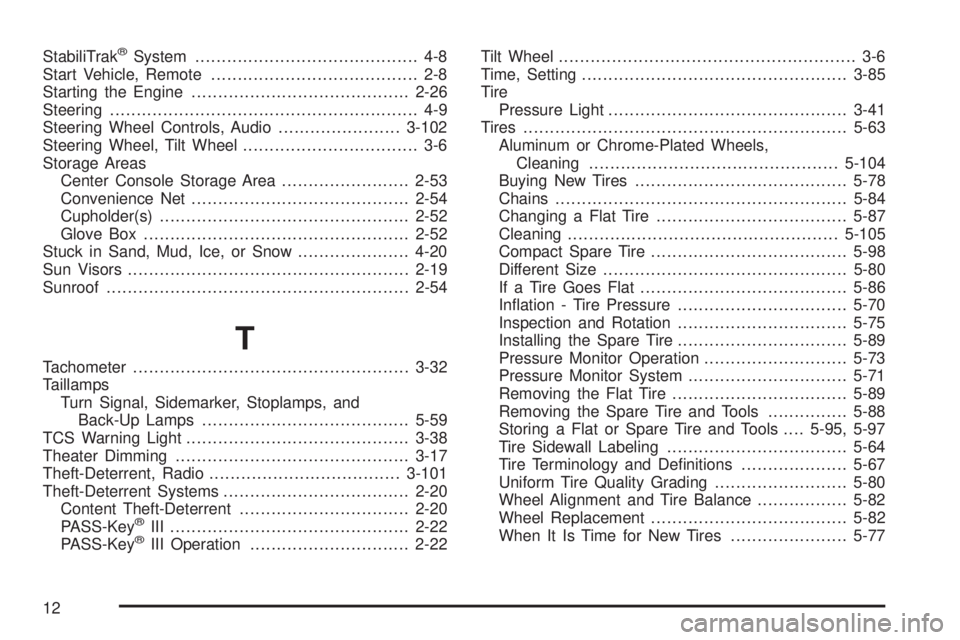Page 279 of 440

{CAUTION:
Fuel can spray out on you if you open the fuel
cap too quickly. If you spill fuel and then
something ignites it, you could be badly
burned. This spray can happen if your tank is
nearly full, and is more likely in hot weather.
Open the fuel cap slowly and wait for any hiss
noise to stop. Then unscrew the cap all the way.
Be careful not to spill fuel. Do not top off or over�ll the
tank and wait a few seconds after you have �nished
pumping before removing the nozzle. Clean fuel from
painted surfaces as soon as possible. SeeWashing Your
Vehicle on page 5-102.
When replacing the fuel cap, turn it clockwise until it
clicks. Make sure the cap is fully installed. The
diagnostic system can determine if the fuel cap has
been left off or improperly installed. This would allow fuel
to evaporate into the atmosphere. SeeMalfunction
Indicator Lamp on page 3-42.
Your vehicle may also have a check gas cap warning
light, which will be displayed on the instrument panel
cluster if the fuel cap is not properly installed. SeeCheck
Gas Cap Light on page 3-49for more information.If your vehicle has a Driver Information Center (DIC),
the CHECK GAS CAP message will be displayed if the
fuel cap is not properly installed. SeeDIC Warnings
and Messages on page 3-58for more information.
{CAUTION:
If a �re starts while you are refueling, do not
remove the nozzle. Shut off the �ow of fuel by
shutting off the pump or by notifying the
station attendant. Leave the area immediately.
Notice:If you need a new fuel cap, be sure to get
the right type. Your dealer/retailer can get one for
you. If you get the wrong type, it may not �t properly.
This may cause your malfunction indicator lamp to
light and may damage your fuel tank and emissions
system. SeeMalfunction Indicator Lamp
on page 3-42.
5-9
Page 345 of 440

To decrease the tire’s air-pressure use the pointed end of
the valve cap, a pencil-style air pressure gage,or a key.
You have two minutes to match each tire and wheel
position. If it takes longer than two minutes to match any
tire and wheel position, the matching process stops and
you need to start over.
The TPMS sensor matching process is outlined below:
1. Set the parking brake.
2. Turn the ignition switch to ON/RUN with the
engine off.
3. Press the Remote Keyless Entry (RKE) transmitter’s
LOCK and UNLOCK buttons at the same time for
approximately �ve seconds. The horn sounds twice
to signal the receiver is in relearn mode and the
TPMS sensor matching process can begin.
4. Start with the driver side front tire.
5. Remove the valve cap from the tire’s valve stem.
Activate the TPMS sensor by increasing or
decreasing the tire’s air pressure for 10 seconds, or
until a horn chirp sounds. The horn chirp, which
may take up to 30 seconds to sound, con�rms that
the sensor identi�cation code has been matched to
the tire/wheel position.6. Proceed to the passenger side front tire, and repeat
the procedure in Step 5.
7. Proceed to the passenger side rear tire, and repeat
the procedure in Step 5.
8. Proceed to the driver side rear tire, and repeat the
procedure in Step 5.
9. After hearing the con�rming horn chirp for the driver
side rear tire, the horn chirps two more times to
signal the tire learning process has ended. Turn the
ignition switch to LOCK/OFF.
10. Set all four tires to the recommended air pressure
level as indicated on the tire and loading information
label.
11. Put the valve caps back on the valve stems.
Tire Inspection and Rotation
We recommend that you regularly inspect your
vehicle’s tires, including the spare tire, for signs of
wear or damage. SeeWhen It Is Time for New
Tires on page 5-77for more information.
Tires should be rotated every 5,000 to 8,000 miles
(8 000 to 13 000 km). SeeScheduled Maintenance
on page 6-4.
5-75
Page 438 of 440

StabiliTrak®System.......................................... 4-8
Start Vehicle, Remote....................................... 2-8
Starting the Engine.........................................2-26
Steering.......................................................... 4-9
Steering Wheel Controls, Audio.......................3-102
Steering Wheel, Tilt Wheel................................. 3-6
Storage Areas
Center Console Storage Area........................2-53
Convenience Net.........................................2-54
Cupholder(s)...............................................2-52
Glove Box..................................................2-52
Stuck in Sand, Mud, Ice, or Snow.....................4-20
Sun Visors.....................................................2-19
Sunroof.........................................................2-54
T
Tachometer....................................................3-32
Taillamps
Turn Signal, Sidemarker, Stoplamps, and
Back-Up Lamps.......................................5-59
TCS Warning Light..........................................3-38
Theater Dimming............................................3-17
Theft-Deterrent, Radio....................................3-101
Theft-Deterrent Systems...................................2-20
Content Theft-Deterrent................................2-20
PASS-Key
®III .............................................2-22
PASS-Key®III Operation..............................2-22Tilt Wheel........................................................ 3-6
Time, Setting..................................................3-85
Tire
Pressure Light.............................................3-41
Tires.............................................................5-63
Aluminum or Chrome-Plated Wheels,
Cleaning...............................................5-104
Buying New Tires........................................5-78
Chains.......................................................5-84
Changing a Flat Tire....................................5-87
Cleaning...................................................5-105
Compact Spare Tire.....................................5-98
Different Size..............................................5-80
If a Tire Goes Flat.......................................5-86
In�ation - Tire Pressure................................5-70
Inspection and Rotation................................5-75
Installing the Spare Tire................................5-89
Pressure Monitor Operation...........................5-73
Pressure Monitor System..............................5-71
Removing the Flat Tire.................................5-89
Removing the Spare Tire and Tools...............5-88
Storing a Flat or Spare Tire and Tools....5-95, 5-97
Tire Sidewall Labeling..................................5-64
Tire Terminology and De�nitions....................5-67
Uniform Tire Quality Grading.........................5-80
Wheel Alignment and Tire Balance.................5-82
Wheel Replacement.....................................5-82
When It Is Time for New Tires......................5-77
12